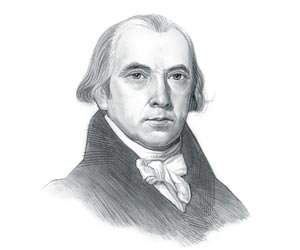|
Summary and Definition
of
the Tariff of 1816
Summary and Definition:
American factories were new and could not compete with
prices of experienced European factories.
The Tariff of 1816 was the first protective
tariff implemented by the government. Its aim was to
make American and foreign manufactured goods comparable
in price and therefore persuade Americans to buy
American products.
Tariff of 1816 for kids: Background History
America was a new nation, free from the yoke of the British in the
Revolutionary War. The War of 1812
(aka 'Second War for Independence' with the British) had
ended in a stalemate but made Americans realize that they needed to
become independent from Britain and the other countries of Europe,
in a commercial and economic sense. Before the War of 1812 the US
had depended on the British for most of their manufactured goods,
84% of people in the country were farmers. During the Napoleonic
Wars and the War of 1812 the blockade of Europe led British
manufacturers to offer goods in the United States at low prices that
the American manufacturers often could not match.
The War of 1812 had created shortages in the
country - the US needed to become self-sufficient. There was a
plentiful supply of natural resources. The US needed factories to
make the goods. The government needed to create a climate in which
American trade would flourish and provide money for the
industrialists. The Tariff of 1816
was part of a plan to reach these goals.
Tariff of 1816 for kids: The
American System
Henry Clay (1777 – 1852) was a great supporter of the American System
- refer to
Henry Clay and the 'American System'.
The American System was an
economic plan based on many of the ideas of Alexander Hamilton that aimed at improving the
economy of the US and the lives of American citizens. The American System was based on:
Taxing all foreign goods, to boost the sales
of US products and protect manufacturers from cheap British goods
(Tariff of 1816)
Establishing another Bank of the United States
to offer easy credit to Americans
Constructing new roads and canals in the West
The Tariff of 1816, placed a 20-25% tax on all foreign
goods. Before the War of 1812, duties averaged about 12.5%.
Significance of the
Tariff of 1816
The
Significance of the Tariff of 1816: The Tariff of 1816 helped American businesses compete with British and
European factories. It heralded the time in American history that is
known as the Era of Good Feelings.
It was the time of great inventions, an Industrial revolution, and
machines like the
Eli Whitney
Cotton Gin
and the
Samuel Slater cotton mill
were revolutionizing the manufacture of American goods. The
protective Tariff of 1816, as part of the 'American System' made it
possible for the government galvanize the manufacturing industries
in America. The country saw the emergence of 'King Cotton' as a cash
crop in the
South and the growth of textile mills, breweries and distilleries
and other factories in the north. The Northerners had particular reason to
support the Tariff of 1816.
Significance of the
Tariff of 1816: Protective Tariffs
The Tariff of 1816 was the first of the protective tariffs.
The Tariff
of 1824 was the second protective tariff and the
Tariff
of 1828 (the Tariff of Abominations) led to the
Nullification Crisis, in
which the sectional interests of the North and the South had truly came into
conflict for the first time.
Protective Tariffs
For additional facts and a timeline
refer to
Protectionism and Tariffs.
|

